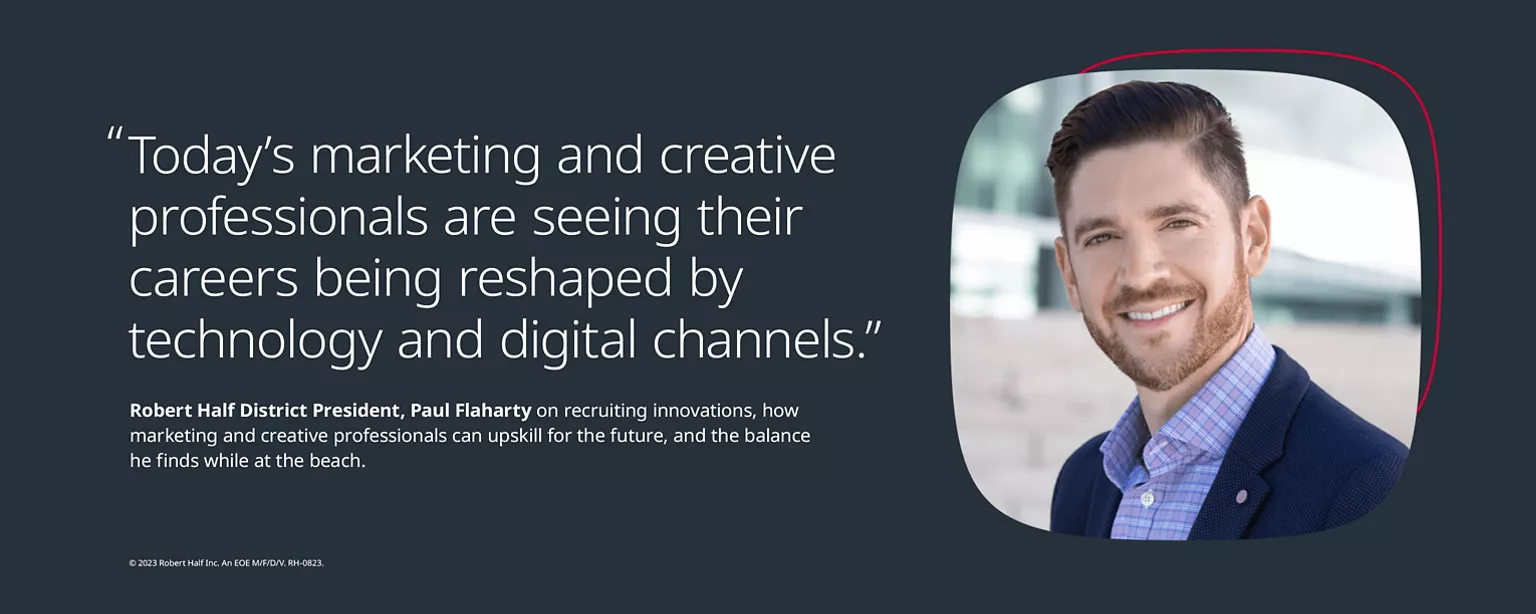Welcome to the latest post in Robert Half’s Thought Leader Q&A series, which features insights from those who have made our company a great place to work and a premier provider of talent solutions.
Paul Flaharty is a district president for Robert Half. He began his career with Robert Half in New York City in 2005. After seven years of building successful operations in the tri-state area, he relocated to Los Angeles, where he has held several leadership positions, including division director, regional vice president and district director. He most recently oversaw operations throughout Southern California and the San Francisco Bay Area for the company’s technology and marketing and creative practices. He recently stepped into the district president role.
Here’s what Paul had to say during our interview, which covered everything from the challenges in the job market to evolving skill sets for marketing professionals and the work-life balancing act of biking to the beach.
How did you begin your career in the talent solutions space, and what do you like most about working for Robert Half?
I started working for a technology staffing firm shortly out of college, and then I met a director of permanent placement services for Robert Half. That led to introductions and interviews, and pretty soon, I was working on Wall Street for Robert Half’s technology practice. I’ve been with the company for more than 16 years now.
What I love about Robert Half is that the company always rewards great work and looks for ways to elevate its employees’ careers. The company has provided me with countless experiences and opportunities. Its thoughtful and strategic leaders set clear expectations with coaching and guidance along the way, always positioning me for long-term career growth.
The last year has been a tough one for recruiting in every industry, and the challenges are likely to continue through 2022. What innovative actions are you seeing companies take to attract the most talented and experienced marketing and creative professionals?
The demand exploded for our talent solutions offerings in 2021 when the pandemic caused a major disruption in the country’s labor force. It was a mindset shift for everyone when a job market with a high supply and low demand for job candidates plunged to one with severe labor shortages.
The challenges have been huge all around, but some of the more strategic companies have shifted to a remote work landscape and expanded their geographic range for recruitment.
As our latest Salary Guide shows, compensation levels have risen, and so have the perks and benefits companies are willing to give their employees, from stipends and bonuses to health and wellness priorities. Smart companies are making outside-of-the box decisions to show their employees they are willing to invest in them.
Read Paul’s thought leadership on Digital Design: Competing for Talent in the Creative Field.
As the marketing industry continues to evolve, what skills do you see as being most valuable as its professionals upskill for the future?
Today’s marketing and creative professionals are seeing their careers being reshaped by technology and digital channels. The in-demand skill sets reflect the extent to which companies are more mindful than ever about how prospective users will interact with their brand. As a result, there’s an incredible amount of focus and budgets being shifted to customer experience, design development, content strategy, research and data analytics.
Professionals who provide that expertise, with the ability to interpret and communicate the data with other departments, have increasingly essential roles in companies.
What are your thoughts on the future of remote hiring and hybrid workplaces for marketing and creative professionals?
The remote work landscape is definitely here to stay, especially for those in the marketing and creative fields. Work-from-home arrangements and flexible scheduling for professionals in this specialization have become options that are expected to continue in the long run.
Workers who are offered the right remote desktop software, connectivity and communication tools find they’re more productive and successful. Whether they’re in design and production, content development and management, public relations, or advertising and marketing, they can work as employees and contract professionals in remote settings all over the world.
Of course, companies have to build the infrastructure and offer the processes and technology to support a connected workplace. Those that do are likely to have an edge in recruiting and retaining top marketing and creative talent.
You live in Los Angeles and must enjoy being able to work from home and avoid the commute you used to have. So, what do you like to do when you’re not working?
When I first moved to LA, I’d say the one thing I was really excited about was the beach. I grew up on the East Coast, and my family would go to the Jersey Shore every summer. But I don't think I went to the beach more than three times in the first five or six years I was in California.
Then the pandemic forced people outside, and I found myself so fortunate to live in this lovely climate. I embraced outdoor activities and took up surfing and biking. Every weekend, I jump on the bike with my kids. We go down to the beach and hang out until it’s time to bike home. My priorities have shifted, and biking and surfing have helped to keep me balanced, which impacts the quality of work I do day to day.
Follow Paul Flaharty on LinkedIn.
Meet other Thought Leaders at Robert Half, such as Michael Lusby and Megan Slabinski. And be sure to subscribe to the Robert Half newsletter for future installments of our Q&A series and to discover more unique stories, experiences and perspectives on the latest hiring trends.







